Sedrick Keh
Should VLMs be Pre-trained with Image Data?
Mar 10, 2025Abstract:Pre-trained LLMs that are further trained with image data perform well on vision-language tasks. While adding images during a second training phase effectively unlocks this capability, it is unclear how much of a gain or loss this two-step pipeline gives over VLMs which integrate images earlier into the training process. To investigate this, we train models spanning various datasets, scales, image-text ratios, and amount of pre-training done before introducing vision tokens. We then fine-tune these models and evaluate their downstream performance on a suite of vision-language and text-only tasks. We find that pre-training with a mixture of image and text data allows models to perform better on vision-language tasks while maintaining strong performance on text-only evaluations. On an average of 6 diverse tasks, we find that for a 1B model, introducing visual tokens 80% of the way through pre-training results in a 2% average improvement over introducing visual tokens to a fully pre-trained model.
DataComp-LM: In search of the next generation of training sets for language models
Jun 18, 2024



Abstract:We introduce DataComp for Language Models (DCLM), a testbed for controlled dataset experiments with the goal of improving language models. As part of DCLM, we provide a standardized corpus of 240T tokens extracted from Common Crawl, effective pretraining recipes based on the OpenLM framework, and a broad suite of 53 downstream evaluations. Participants in the DCLM benchmark can experiment with data curation strategies such as deduplication, filtering, and data mixing at model scales ranging from 412M to 7B parameters. As a baseline for DCLM, we conduct extensive experiments and find that model-based filtering is key to assembling a high-quality training set. The resulting dataset, DCLM-Baseline enables training a 7B parameter language model from scratch to 64% 5-shot accuracy on MMLU with 2.6T training tokens. Compared to MAP-Neo, the previous state-of-the-art in open-data language models, DCLM-Baseline represents a 6.6 percentage point improvement on MMLU while being trained with 40% less compute. Our baseline model is also comparable to Mistral-7B-v0.3 and Llama 3 8B on MMLU (63% & 66%), and performs similarly on an average of 53 natural language understanding tasks while being trained with 6.6x less compute than Llama 3 8B. Our results highlight the importance of dataset design for training language models and offer a starting point for further research on data curation.
SEACrowd: A Multilingual Multimodal Data Hub and Benchmark Suite for Southeast Asian Languages
Jun 14, 2024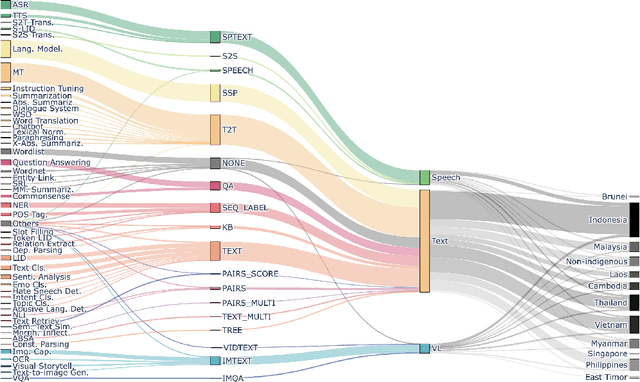
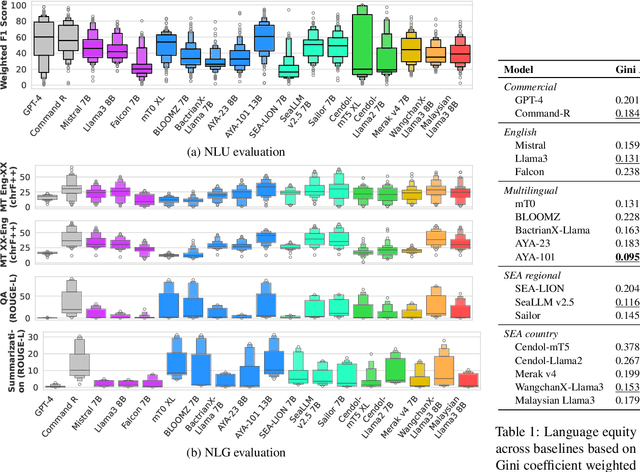
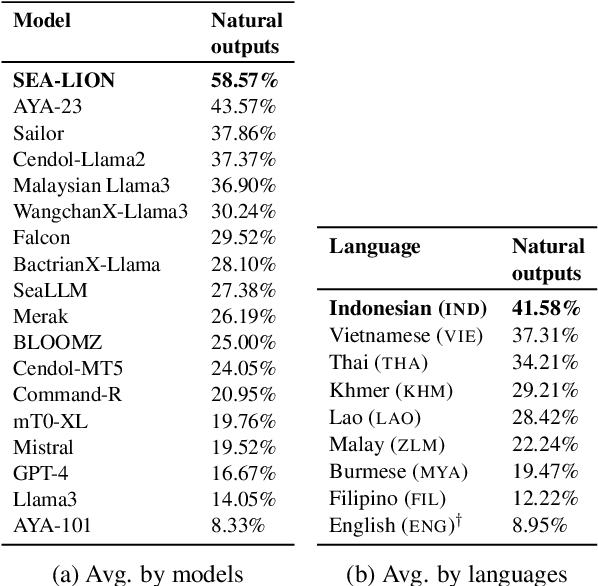
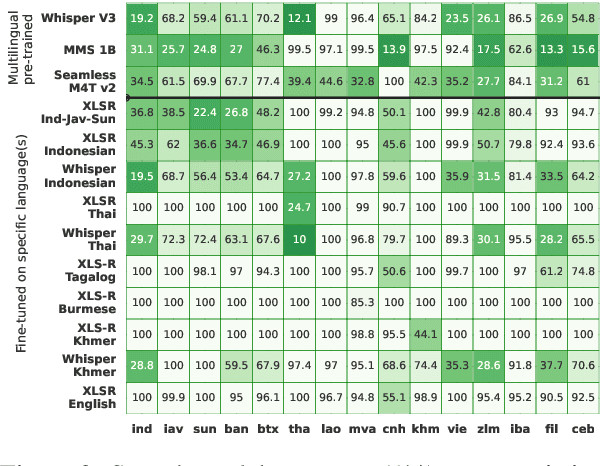
Abstract:Southeast Asia (SEA) is a region rich in linguistic diversity and cultural variety, with over 1,300 indigenous languages and a population of 671 million people. However, prevailing AI models suffer from a significant lack of representation of texts, images, and audio datasets from SEA, compromising the quality of AI models for SEA languages. Evaluating models for SEA languages is challenging due to the scarcity of high-quality datasets, compounded by the dominance of English training data, raising concerns about potential cultural misrepresentation. To address these challenges, we introduce SEACrowd, a collaborative initiative that consolidates a comprehensive resource hub that fills the resource gap by providing standardized corpora in nearly 1,000 SEA languages across three modalities. Through our SEACrowd benchmarks, we assess the quality of AI models on 36 indigenous languages across 13 tasks, offering valuable insights into the current AI landscape in SEA. Furthermore, we propose strategies to facilitate greater AI advancements, maximizing potential utility and resource equity for the future of AI in SEA.
Linearizing Large Language Models
May 10, 2024



Abstract:Linear transformers have emerged as a subquadratic-time alternative to softmax attention and have garnered significant interest due to their fixed-size recurrent state that lowers inference cost. However, their original formulation suffers from poor scaling and underperforms compute-matched transformers. Recent linear models such as RWKV and Mamba have attempted to address these shortcomings by proposing novel time-mixing and gating architectures, but pre-training large language models requires significant data and compute investments. Thus, the search for subquadratic architectures is limited by the availability of compute and quality pre-training datasets. As a cost-effective alternative to pre-training linear transformers, we propose Scalable UPtraining for Recurrent Attention (SUPRA). We present a method to uptrain existing large pre-trained transformers into Recurrent Neural Networks (RNNs) with a modest compute budget. This allows us to leverage the strong pre-training data and performance of existing transformer LLMs, while requiring 5% of the training cost. We find that our linearization technique leads to competitive performance on standard benchmarks, but we identify persistent in-context learning and long-context modeling shortfalls for even the largest linear models. Our code and models can be found at https://github.com/TRI-ML/linear_open_lm.
Language models scale reliably with over-training and on downstream tasks
Mar 13, 2024



Abstract:Scaling laws are useful guides for developing language models, but there are still gaps between current scaling studies and how language models are ultimately trained and evaluated. For instance, scaling is usually studied in the compute-optimal training regime (i.e., "Chinchilla optimal" regime); however, in practice, models are often over-trained to reduce inference costs. Moreover, scaling laws mostly predict loss on next-token prediction, but ultimately models are compared based on downstream task performance. In this paper, we address both shortcomings. To do so, we create a testbed of 104 models with 0.011B to 6.9B parameters trained with various numbers of tokens on three data distributions. First, we investigate scaling in the over-trained regime. We fit scaling laws that extrapolate in both the number of model parameters and the ratio of training tokens to parameters. This enables us to predict the validation loss of a 1.4B parameter, 900B token run (i.e., 32$\times$ over-trained) and a 6.9B parameter, 138B token run$\unicode{x2014}$each from experiments that take 300$\times$ less compute. Second, we relate the perplexity of a language model to its downstream task performance via a power law. We use this law to predict top-1 error averaged over downstream tasks for the two aforementioned models using experiments that take 20$\times$ less compute. Our experiments are available at https://github.com/mlfoundations/scaling.
A Critical Evaluation of AI Feedback for Aligning Large Language Models
Feb 19, 2024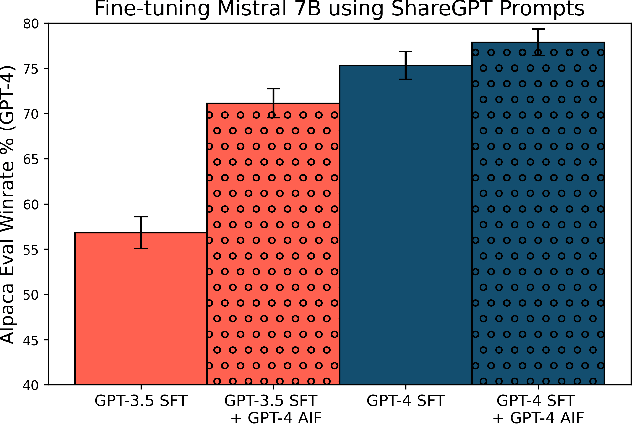

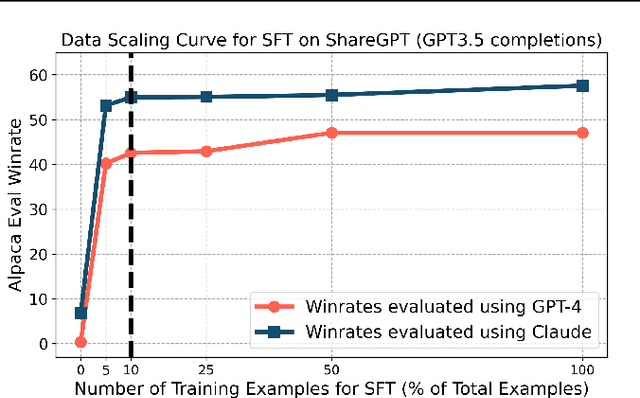
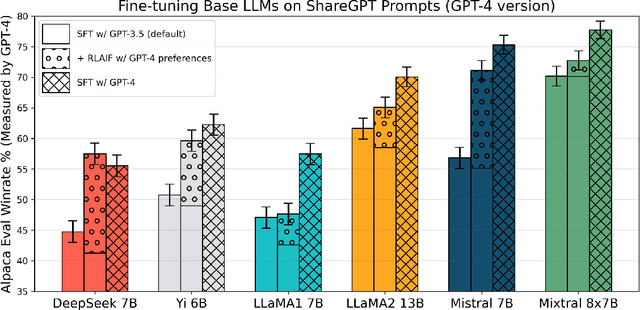
Abstract:Reinforcement learning with AI feedback (RLAIF) is a popular paradigm for improving the instruction-following abilities of powerful pre-trained language models. RLAIF first performs supervised fine-tuning (SFT) using demonstrations from a teacher model and then further fine-tunes the model with reinforcement learning (RL), using feedback from a critic model. While recent popular open-source models have demonstrated substantial improvements in performance from the RL step, in this paper we question whether the complexity of this RL step is truly warranted for AI feedback. We show that the improvements of the RL step are virtually entirely due to the widespread practice of using a weaker teacher model (e.g. GPT-3.5) for SFT data collection than the critic (e.g., GPT-4) used for AI feedback generation. Specifically, we show that simple supervised fine-tuning with GPT-4 as the teacher outperforms existing RLAIF pipelines. More generally, we find that the gains from RLAIF vary substantially across base model families, test-time evaluation protocols, and critic models. Finally, we provide a mechanistic explanation for when SFT may outperform the full two-step RLAIF pipeline as well as suggestions for making RLAIF maximally useful in practice.
Asking More Informative Questions for Grounded Retrieval
Nov 14, 2023Abstract:When a model is trying to gather information in an interactive setting, it benefits from asking informative questions. However, in the case of a grounded multi-turn image identification task, previous studies have been constrained to polar yes/no questions, limiting how much information the model can gain in a single turn. We present an approach that formulates more informative, open-ended questions. In doing so, we discover that off-the-shelf visual question answering (VQA) models often make presupposition errors, which standard information gain question selection methods fail to account for. To address this issue, we propose a method that can incorporate presupposition handling into both question selection and belief updates. Specifically, we use a two-stage process, where the model first filters out images which are irrelevant to a given question, then updates its beliefs about which image the user intends. Through self-play and human evaluations, we show that our method is successful in asking informative open-ended questions, increasing accuracy over the past state-of-the-art by 14%, while resulting in 48% more efficient games in human evaluations.
 Add to Chrome
Add to Chrome Add to Firefox
Add to Firefox Add to Edge
Add to Edge